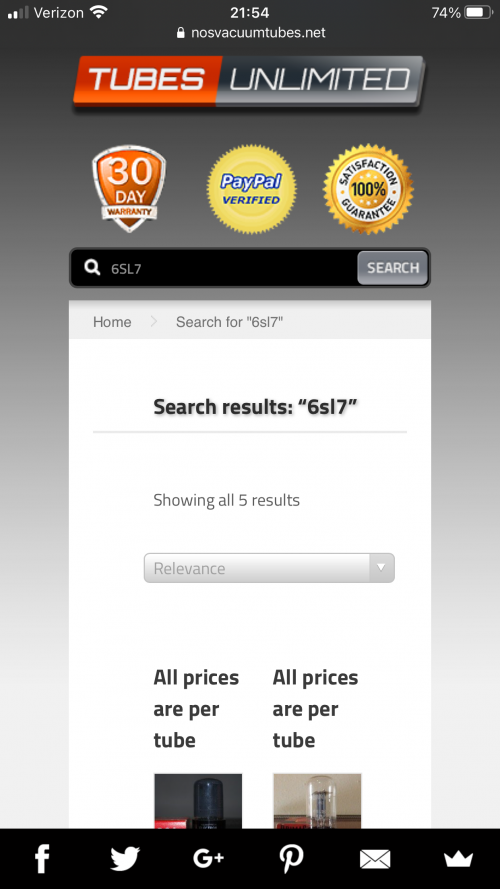I’ve been slow updating this thread. Too busy listening…
The first set of tubes that I used that really showed what the HP4 could do was the Amperex 6SL7GT. This is a tall bottle tube, with chome plates. It’s got a clear top, with the getter on the side. My guess is that Amperex only marketed the tube, but that is was actually made by GE. There are a bunch of GE tubes that have the same construction, but most that I’ve run across are short-bottles…ideal for the HP4, and on my list of tubes to try.
This tube does it all. The headphone that I’m using to guage these tubes is the R10, my primary headphone on the EAR. I’ve often described the bass on the R10 as lean. Further, the R10 has a tendency to add a coloration to the sound, that I suspect is due to lack of dynamics. While it often sounds absolutely gorgeous on acoustical music, high powered electric music can be found wanting. Not with these tubes! The first thing you notice is impact. A drum sounds like a drum, with fundamentals that go deep. The speed of the R10 picks up piano notes better than any other headphone I’ve heard, if the amp will let it. This tube lets it. The laid back coloration that the R10 can exhibit is just not there with this tube. Clean, clear sound. Smooth tube delivery, but faster than almost any solid state amp I’ve heard. This would have been the end of my tube rolling in the EAR, I think, but the tube gods decided otherwise. One of my quad went noisy after being in use only a week. Tubes, particularly NOS, are at risk of this, particularly during the first month. So, one of my best tubes was no longer suitable for audio use, and I had to roll it to…
Sylvania VT-229. A classic. The matched quad of these I used was from 1943. Gray plates, with a bottom getter. The first thing I noticed was the detail. As clean and as clear as the Amperex was, the Sylvania did it better. Everything was laid out in front of you. But something wasn’t quite right. The bass response on this tube was not as good as the Amperex. Where I had been listening to bass lines, they started becoming indistinct on the R10…bad. The impact that the Amperex delivered wasn’t there. Imaging was another issue. As good as the detailing was, it didn’t seem to cohere into a soundstage. I finally realized I wasn’t enjoying music as much with this tube as with the Amperex. The differences were not large, and my description of them is making them sound bigger than they were. To put it in perspective, I would not be unhappy if I had to live with this tube on a permanent basis. But, having heard the Amperex, I knew it was possible to do better…
Valvo 6SL7GT. When you get into tubes, you learn about Telefunken and Siemens very quickly. But they weren’t the only German tube makers. Valvo was the third largest of the German manufacturers, but their tubes didn’t give up anything in quality. The Valvo 6SL7GT has grey plates and a bottom getter, in the tallest bottle I’ve seen in a 6SL7. These have only been in the EAR for two days, so impressions don’t have as much time on them as the other tubes, but…
Wow! The Valvo may be the most complete of the 6SL7’s I’ve heard so far. It’s got the detail of the Sylvania beaten, with the impact and fast sound of the Amperex. I had looked at the bass response of the R10 when the VT-229’s were in place, and got nothing below 30 Hz. Switching to the Valvo produced output down at 25 Hz. This was felt, rather than heard, but it was there. The soundstage has snapped back into focus. Much clearer than the VT-229’s. Every instrument has its place. Nothing sounds crowded or smeared. You can clearly hear background instruments being recorded at low volume underneath the leads, if you want. The sound of this tube with the R10 is extremely seductive. This is as close to transparent as I’ve heard in a headphone system. It’s difficult to describe a sonic signature, because it’s difficult to hear one. What you hear are instruments playing music, not the audio equipment. So far, this is the best of the tubes I’ve heard in the EAR…but the real test will be what it sounds like in a week or two…







